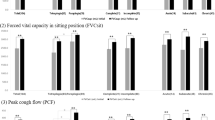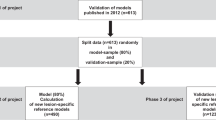Abstract
Spirometry was performed on 165 subjects with spinal cord injury (84 with quadriplegia and 81 with paraplegia). Subjects were characterized by level of lesion as: high quadriplegia (HQ, C4 and above not requiring mechanical ventilation), low quadriplegia (LQ, C5–8), high paraplegia (HP, T1–7), and low paraplegia (LP, T8–L3). Thirty-nine subjects had complete motor lesions, and 126 had incomplete motor lesions. Nonsmokers (54 with quadriplegia and 53 with paraplegia) were defined as those who had never smoked or those who had stopped smoking for 1 year. Current smokers (28 with quadriplegia and 28 with paraplegia) were defined as those who currently smoked cigarettes, cigars, and/or pipe or those who had quit for ⩽1 year. We found by linear regression analysis that forced vital capacity (FVC), forced expiratory volume in 1 s (FEV1), peak expiratory flow (PEF), and maximal voluntary ventilation (MVV) were inversely correlated with the level of injury (i.e., the higher the level of injury, the lower the parameter). In the HQ group, those with complete injury had significantly lower pulmonary function parameters than those with incomplete lesions. In contrast, there were no significant differences in pulmonary function parameters between complete and incomplete lesions in subjects in the LQ, HP, and LP groups. In the LQ, HP, and LP groups, the FEV, and PEF were significantly lower in smokers than in nonsmokers. Thus, this study demonstrates the effects of completeness of injury and smoking on pulmonary function in a large group of subjects with spinal cord injury.
Similar content being viewed by others
References
Almenoff PL, Alexander L, Spungen AM, Lesser M, Bauman WA (1995) Bronchodilatory effects of ipratropium bromide in subjects with quadriplegia. Paraplegia, in press
American Thoracic Society (1991) Lung function testing: selection of reference values and interpretative strategies. Am Rev Respir Dis 144:1202–1218
American Thoracic Society (1987) Snowbird Workshop on Standardization of Spirometry. Am Rev Respir Dis 119:831–838
American Thoracic Society (1987) Standard of spirometry: 1987 update. Am Rev Respir Dis 136:1285–1298
Anke A, Aksnes AK, Stanghelle JK, Hjeltnes N (1993) Lung volumes in tetraplegic patients according to cervical spinal cord injury level. Scand J Rehabil Med 25:73–77
Ashba J, Garshick E, Tun CG, Lieberman SL, Polakoff DF, Bluechadd JD, Brown R (1993) Spirometry-acceptability and reproducibility in spinal cord injured subjects. J Am Paraplegia Soc 16:197–203
Barnes PJ (1986) Neural control of human airways in health and disease. Am Rev Respir Dis 134:1289–1314
Bergofsky EH (1964) Mechanism for respiratory insufficiency after cervical cord injury. Ann Intern Med 61:435–447
Bluechardt MH, Wiens M, Thomas SG, Plyley MJ (1992) Repeated measurements of pulmonary function following spinal cord injury. Paraplegia 30:768–774
Chen CF, Lien IN, Wu MC (1992) Respiratory function in patients with spinal cord injuries: Effects of posture. Paraplegia 8:81–86
Dicpinigaitis PV, Spungen AM, Bauman WA, Absgarten A, Almenoff PL (1994) Bronchial hyperresponsiveness after cervical spinal cord injury. Chest 105:1073–1075
Fishburn MJ, Marino RJ, Ditunno JF (1990) Atelectasis and pneumonia in acute spinal cord injury. Arch Phys Med Rehabil 71:197–200
Forner JV (1980) Lung volumes and mechanics of breathing in tetraplegics. Paraplegia 18:258–266
Fugl-Meyer AR (1971) Effects of respiratory muscle paralysis in tetraplegic and paraplegic patients. Scand J Rehabil Med 3:141–150
Fugl-Meyer AR, Grimby G (1971) Ventilatory function in tetraplegic patients. Scand J Rehabil Med 3:151–160
Gardner RM, Clausen JL, Cotton DJ, Crapo RO, Hankinson JL, Johnson RL (1986) Computer guidelines for pulmonary laboratories. Am Rev Respir Dis 134:628–629
Haas A, Lawman EW, Bergofsky EH (1965) Impairment of respiration after spinal cord injury. Arch Phys Med Rehabil 46:399–405
Haas F, Axen K, Pineda H, Gandino D, Haas A (1985) Temporal pulmonary function changes in cervical cord injury. Arch Phys Med Rehabil 66:139–144
Hemingway A, Bors E, Hobby RP (1958) An investigation of the pulmonary function of paraplegics. J Clin Invest 37:773–782
Hey JA, Del Prado M, Chapman RW (1990) Activation of a novel medullary pathway elicits a vagal, cholinergic bronchoconstriction in guinea-pigs. Pulm Pharmacol 3:53–54.
Hey JA, Del Prado M, Chapman RW (1993) Central nervous system control of bronchomotor tone: pharmacological characterization of parasympathetic constrictor and sympathetic inhibitory responses in guinea-pigs. J Auton Pharmacol 13:341–350.
Jackson AB, Groomes TE (1991) Incidence of respiratory complications following spinal cord injury. J Am Paraplegia Soc 14:87.
Kokkola K, Moller K, Lehtonen T (1975) Pulmonary function in tetraplegic and paraplegic patients. Ann Clin Res 7:76–79
Lanig IS, Lammertse DP (1992) The respiratory system in spinal cord injury. Phys Med Rehabil Clin North Am 3(4):725–740
Ledsome JR, Sharp JM (1981) Pulmonary function in acute cervical cord injury. Am Rev Respir Dis 124:41–44
McKinley AC, Auchincloss HJ, Gilbert R, Nicholas JJ (1969) Pulmonary function, ventilatory control, and respiratory complications in quadriplegic subjects. Am Rev Resp Dis 100:526–532
McMichan JC, Michel L, Westbrook PR (1980) Pulmonary dysfunction following traumatic quadriplegia. JAMA 243:528–531
Morris JF, Koski A, Johnson LC (1971) Spirometric standards for healthy nonsmoking adults. Am Rev Respir Dis 103:57–67
Ohry A, Molho M, Rozin R (1975) Alterations of pulmonary function in spinal cord injured patients. Paraplegia 13:101–108
Polatty RC, McElaney MA, Marcelino V (1987) Pulmonary complications in the spinal cord injury patient. Phys Med Rehabil 1(3):353–373
Reines HD, Harris RC (1987) Pulmonary complications of acute spinal cord injuries. Neurosurgery 21(2):193–196
Richardson JB (1979) Nerve supply to the lungs. Am Rev Respir Dis 119:785–802
Spungen AM, Dicpinigaitis PV, Almenoff PL, Bauman WA (1993) Pulmonary obstruction in individuals with cervical spinal cord lesions unmasked by bronchodilator administration. Paraplegia 31:404–407
Stone DJ, Keltz H (1963) The effect of respiratory muscle dysfunction on pulmonary function. Am Rev Resp Dis 88:621–629
Author information
Authors and Affiliations
Additional information
Offprint requests to: Peter L. Almenoff
Rights and permissions
About this article
Cite this article
Almenoff, P.L., Spungen, A.M., Lesser, M. et al. Pulmonary function survey in spinal cord injury: Influences of smoking and level and completeness of injury. Lung 173, 297–306 (1995). https://doi.org/10.1007/BF00176893
Accepted:
Issue Date:
DOI: https://doi.org/10.1007/BF00176893




